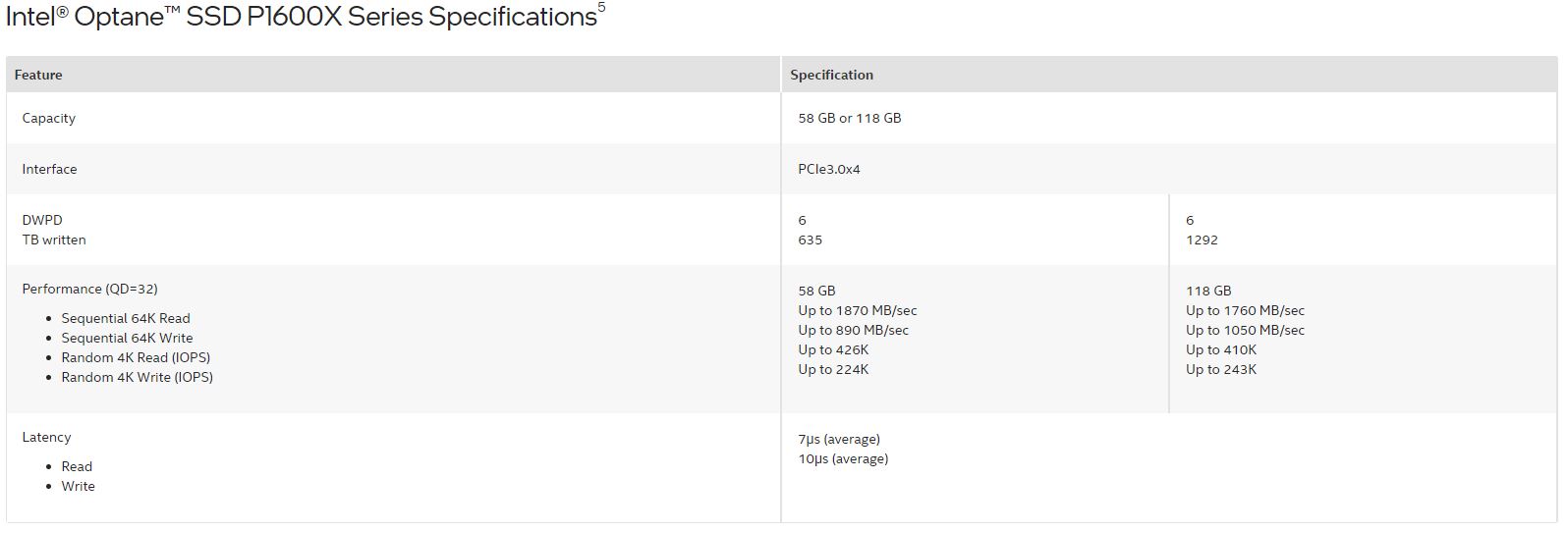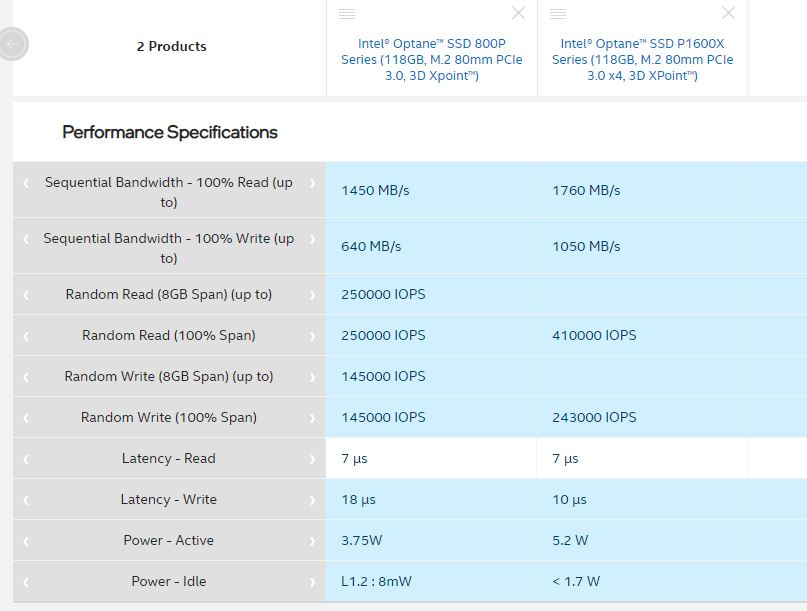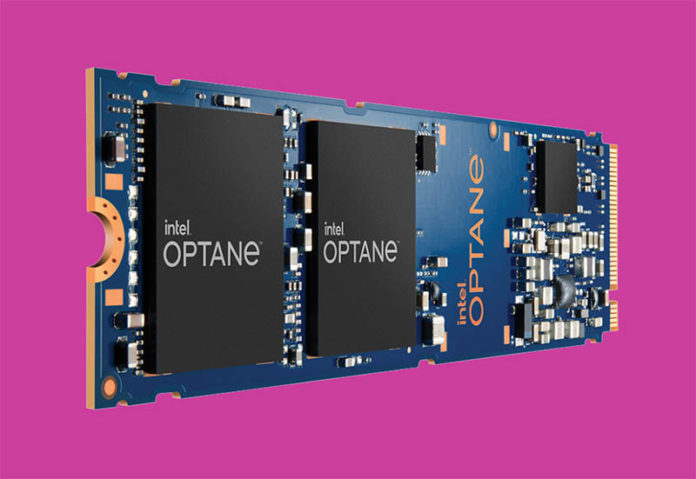This is one of those launches in the industry which is nothing short of perplexing. The Intel Optane P1600X carries a naming convention similar to other data center SSDs. It is also specifically marketed towards the data center on its product page. Yet, it is perhaps one of the stranger spec drives out there.
Intel Optane P1600X SSD
Usually, we would have the specs at the end of an article like this, but today we are going to put them up front. Here is the spec table for the 58GB and 118GB NVMe SSDs.

Let us get into some of the interesting parts. First, these are very small SSDs that are at the capacity we usually see for SATADOMs instead of mainstream SSDs. Second, they are still PCIe Gen3 drives, not PCIe Gen4. Third, they have features like 6DWPD which is less impressive than one may think.
Given the PCIe Gen3 interface and capacities, one may immediately think back to the Intel Optane 800P 58GB and 118GB M.2 SSD series. Here are the specs:

As one can see, this is a PCIe Gen3 x4 instead of an x2 drive and we get more performance. Still, the raw read/ write sequential performance is nowhere near a PCIe Gen4 NVMe SSD. For boot, it is often the random IOPS that increase speed.
The 6DWPD claim is very interesting as well. For example, 118GB at 6DWPD = 708GB written That is about 1.5DWPD for a 512GB drive or 0.7DPWD for a 1TB NAND drive. Still, boot drives tend not to focus on DWPD. When an OS is loaded onto a boot drive, it often sees the core OS files stay static. In some cases, log files are written to the drive but the majority of the drive has data that infrequently changes.
The 2M hour MTBF number is more in-line with most data center SSDs and higher than consumer drives which are usually in the 1.6M hour range.
Final Words
To us, the big challenge is capacity. In some applications, we have deployed very small boot drives but we tend to deploy 256GB and larger drives these days as NAND prices have fallen. If anything, one gets stung by low capacity usually before having a bit of extra capacity in a server or embedded device.
This is certainly an interesting drive, but it is also one we want to see pricing on before we would buy it. The NAND SSDs offerings for boot are generally very good these days so a low capacity Optane option has some headwinds. The random performance may help to the point that, for example, in a firewall, a reboot can happen faster saving seconds in bringing a service back. Perhaps that is the big win for this device.
Our other sense is that this may be an interesting lower cost and low-capacity log device for some servers when a NAND SATA DOM is used with low endurance and capacity.




Seems to be very similar to the Optane 815p which has somehow vanished from Intel ark.
Interestingly the p1600x features “enhanced power loss protection” according to ark. the 800p does not. I think they could be interesting for very low-end zlog use-cases if they turn out to be cheaper than the 100GB P4801X or if only m.2 80mm fits.
It would definitely be nice as a small time slum-SLOG. According to Intel Arc these even have slightly better latency values than the 4801X did. The on paper write IOPS are also almost 200K higher. With all the other “consumer” (read below $1K / unit) optane options being killed off, I bet this will be $400. lol. Your move Intel.
Intel gotta do something with the old unsold stock. Gelsinger’s garage has limited capacity.
Don’t forget most default OS installs tend to use the OS drive as swap space. These 6DWPD seem quite nice in hindsight.
It’s come a long way {down} from the original 2015 promise of “1000x faster than NAND, 1000x the endurance of NAND, and 10x denser than DRAM.”
re: “…most default OS installs tend to use the OS drive as swap space.”
Is that still a material factor? Not having kept up on it, I’d expect most server builds these days to size DRAM for no-swap in normal ops. In any case, DRAM installs these days can easily, perhaps routinely, dwarf the capacities of these new Optanes.
Perfect for the zfs slog device in my homelab, if the cost isn’t too prohibitive…
M2280 and <5W means this should be fine in a high end laptop.
the possibilities for laptops that have 3 M2 slots – iirc the P7x ThinkPads do – should be interesting, especially for some scene rendering jobs that need to swap.
I commented expecting to be disappointed and not find PLP on the Ark – please forgive me for doubting STH! – but I’m still in shock because this is precisely what I have been waiting for, to pull the trigger for a long delayed mobile workstation
(the Panasonic Letsnote 12″ a colleague has just brought back from Japan has a 2TB PCIE4 SSD that made me realise that it has to be a considered decision to invest in a high end mobile ws before the next generation ships v4. That little thing is beyond cute – optical multi writer, Xe embedded graphics, 32GB RAM… right until you ask how much that configuration cost : most of $7K with spare high capacity batteries, custom options maxed (Latin keyboard deletes the visual snowstorm of back-lit scripts) and UK VAT sales / import tax of 20%. We’re proudly informed that our Japanese customers are duly impressed – more by our friend’s logistical prowess to acquire his pride and joy, than by anything else. The betting odds are now for how long before the same clients find a way to politely inquire if the expense has been borne by our company and is padding their invoices . )
Depending on price, these might be fine as a cache drive for a small DIY NAS. Optane has been a surprisingly good fit for that niche use-case over traditional NAND flash.
@Bob Niland
Servers still need a little bit of swap space. It doesn’t have to be much, but it has been shown to help smooth out operations. Linux kind of expects it, so…
180 EUR… Pfff. Expensive.
So how much does it cost?
Where can I get it?
Sounds like a perfect OS Drive to me.